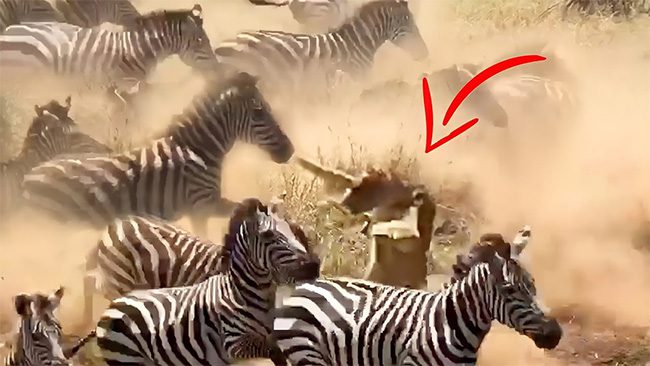The Lion’s Risky Choice Almost Cost It Its Life, But Resulted in an Unexpected Outcome.
Video: Maasai Sightings.
Zebras are one of the favorite prey of lions. However, to hunt these large animals, lions must move in packs and coordinate with each other to separate them from the herd, and then work together to bring them down.
In many cases, when the number of zebras in the herd is overwhelming, lions have to gamble with fate and face a high risk of being trampled to injury, as seen in a situation recorded by a tourist in a nature reserve in Tanzania.
The clip shows a pride of lions forming a strategy and attacking the herd of zebras from various directions. While those at the back are relatively safe as they just need to chase the prey, some lions position themselves in dangerous spots, right in the path of the large herd of zebras.
Typically, these individuals serve as the “links” in the lion’s hunting strategy, as they ambush at critical points and attack zebras where they least expect it.
However, if luck is not on their side, these lions can easily sustain serious injuries or even lose their lives. In the clip, one lion appears to misjudge the timing and misses its prey. Immediately, it is punished by the herd of zebras, enduring a barrage of powerful kicks.
Fortunately, despite rolling several times on the ground, the lion managed to escape death and used its remaining strength to crawl out of the herd’s path. In exchange for this recklessness, the pride succeeded in their hunt, taking down two zebras in just a few brief seconds.

Charging into the herd of zebras, the lion was nearly trampled to death
In Western culture, lions are often referred to as the “King of the Jungle” or “King of Beasts.” They are also the most social of all wild cat species, living in groups that are related to their offspring.
Whether hunting or defending themselves, lions are never alone. They prefer to operate in small groups, using their skills, strength, and speed to take down their opponents.
As a result, they are exceptional predators and top carnivores on the savannah. Scientific studies have shown that the lions’ ability to hunt in packs is a key factor that increases their success rate when hunting large and dangerous prey.
Despite their large size, lions can run very fast, especially lionesses. Lions can reach speeds of over 80 km/h, although they can only maintain this speed for a short time.
Lions also know how to swim and climb trees, but they tend to be quite clumsy. Many videos have captured lions climbing trees to steal prey from leopards or swimming across rivers to follow herds of grazing animals, as well as searching for their own territory.
Despite having many advantages for survival, lion populations in Africa have declined by about 43% since the early 1990s. Although the causes of this decline have not been fully clarified, habitat loss and conflicts with humans are the biggest contributors.


















































